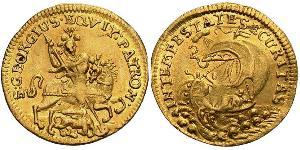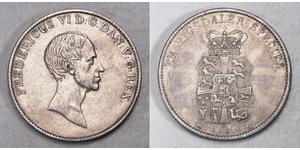Ducat
The first issue of this coin is thought to have been under Roger II of Sicily, who, in 1140, coined ducats bearing the figure of Christ, and the inscription, ‘Sit tibi, Christe, datus, quem tu regis iste ducatus’ (or roughly, “O Christ, let this duchy which you rule be dedicated to you.” This seems to be a reference to Matthew 22:19-21).
Austrian Gold-Dukaten depicting Kaiser Franz-Josef, c. 1910
The ducat was introduced by the Republic of Venice in 1284 under the doge Giovanni Dandolo (1280-1289). The Venetian ducat, called zecchino, featured the Doge kneeling before St. Mark on the obverse and Jesus on the reverse. During the Middle Ages the ducat gained much popularity, as it was easy to mint, and packed quite a value in one relatively small coin. Several cities and small states in Europe – mostly Eastern Europe in the Middle Ages – issued multiple, single and fractional ducats. The standard of coin was adopted in Hungary; and for a long time all foreign coins bore the name Ongri, Italian for “Hungarian”, where the trade of the world at this period was concentrated. They did not become popular in Germany until a later date.
The Golden Bull of Charles IV gave to all members of the empire the privilege of issuing gold coins, with any stamp they chose; but these were only gold guilders, equivalent to the florin.
Ducats became a standard gold coin throughout Europe, especially after it was officially imperially sanctioned in 1566. The ducat remained sanctioned until 1857. To make it more confusing there was also a silver ducat minted in many European nations. The Royal Dutch Mint still issues silver ducats with a weight of 28.25 grams.
The most common type of ducat were the old Dutch ducats, bearing the impression of an armed figure, which gave way, for a short time only, to the figure of Louis II of Flanders. They circulated almost as merchandise, but had been frequently counterfeited in the Grisons. The counterfeits were very good in appearance, both in weight and sound.
According to 1913 Webster the ducat was worth the equivalent of “nine shillings and four pence sterling, or somewhat more than two dollars. The silver ducat is of about half this value.” The ducat itself was worth an amount of money, but it was not written down in other denominations, such as its exact worth in German marks, dollars or any other currency of that time. Many say that a ducat is 500 dollars in Mexico, Czechoslovakia, and The Netherlands. Even now some national mints produce batches of ducats made after old patterns as bullion gold and banks sell these coins to private investors or collectors.
1 Speciedaler Denmark Silver Frederick VI of Denmark (1768 -1839)
group has 8 coins / 6 prices
⇑








